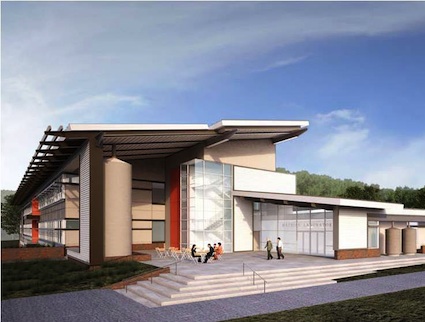Green Lab for Green Science Under Way

(Credit: EwingCole) Architect’s image of new Mathias Lab, complete with rain cistern on porch and wetlands to the left.
EDGEWATER, Md. — Expansion of a research laboratory at the Smithsonian Environmental Research Center in Maryland is under way and slated for completion in late 2013.
The $45,000,000 project was designed by Philadelphia-based architecture and engineering firm EwingCole. The firm’s renderings were revealed at a groundbreaking in May.
“It was important to SERC that the landscape and building be designed as an integrated whole,” said Howard Skoke, lead architect and principal of EwingCole’s science & technology practice. “We worked closely with administrators, scientists, and staff to create a project that meets current needs with great efficiency but is also flexible enough to accommodate program changes in the future.”
The two-story, 90,000-square-foot facility is named in honor of the late U.S. Senator Charles “Mac” Mathias (R-MD) and will be home to an interdisciplinary team of more than 180 researchers, technicians, and students.
Research at the center will address global climate change, the effects of nutrients and chemicals passing through landscapes, maintenance of productive fisheries, changes to the environment from biological invaders, and protection of fragile wetlands and woodlands, firm officials said.
“The Mathias Laboratory project is a cornerstone of the Smithsonian’s environmental research, education, and commitment to sustainability,” said Smithsonian Secretary Wayne Clough.
To meet both sustainable design needs and long-term cost efficiency, the design firm used energy modeling and Laboratories for the 21st Century design guidelines for project development.
When completed, school officials expect the facility to be one of the most energy-efficient and sustainable research laboratories in the world.
Smithsonian officials said that while there has been an increase in the number of sustainable offices and homes, creating a more sustainable laboratory, especially one where fume hoods for chemistry research can consume up to three times as much energy as an average home, presents an even greater challenge.
The new facility, which is being built by LEED Gold certification standards, is expected to consume at least 37 percent less energy and emit 37 percent less carbon dioxide than a similar building that meets only the bare requirements of LEED certification, according to research center officials.
Sustainable features include heat recovery of laboratory exhaust air, demand control ventilation in laboratory spaces, and water conservation and storm water management and recovery.
The facility also includes a ground source geothermal well field system central plant used for both heating and cooling.
The current 21,000 feet of lab space will undergo “massive” remodeling, with 21,000 square feet of new lab, office, and support space.
A two-story atrium will connect the old and new sections and create a space where scientists from different departments can share ideas.
“This new laboratory represents a renewed long-term commitment by the Smithsonian to world-class environmental research on the Chesapeake Bay estuary and watershed, and on coastal ecosystems around the world,” said Anson Hines, director of the Smithsonian Environmental Research Center.
